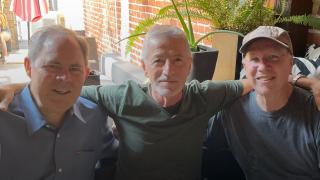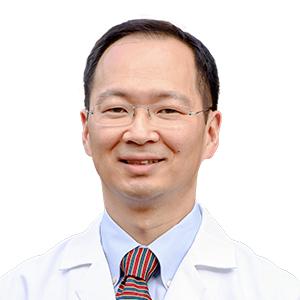At first glance, there was nothing unusual about the party of five having lunch recently at a popular cafe in Monrovia, California, down the road from City of Hope’s Duarte campus. It looked pretty much like any other group of good friends, eating, drinking, laughing, sharing stories. Thoroughly unremarkable.
Unless you knew.
Seated at the table were Jim Murphy, Bruce Austin and Jorjik Pourghassamians, three sixtysomething gentlemen who’ve learned the hard way to never again take the simple act of consuming food for granted. Each had survived a bout with esophageal cancer, undergoing radiation, chemotherapy and radical surgery that rearranged his insides, removing large sections of his esophagus and stomach.
The other two?
Tami Tittelfitz, the City of Hope nurse practitioner who shepherded all three through their treatment and recovery.
And Jae Kim, M.D., the surgeon who saved their lives.
“We truly are blessed to have this five-way connection, and truly grateful for each other,” said Murphy, a semi-retired commercial landscaper, avid mountain biker and skier (he’s a longtime member of the Big Bear Ski Patrol). Murphy, the “senior” patient, was diagnosed and treated in 2013 after he noticed some difficulty swallowing. An outgoing, gregarious veritable force of nature, Murphy is a relentlessly positive, “push forward” kind of guy who biked to his treatments, kept working through chemo and radiation, and says he’s even more active now. He’s told his story many times.
Murphy wanted to give back, share his story and provide encouragement to others. That’s how he met Austin, who is now marking a critical milestone of his own: five years cancer free. The lunch was in his honor.
Together with Pourghassamians, the three comprise a unique and vital support group, offering friendship and important “been there” advice to each other and, they promise, to future patients.
A Rare Cancer
Esophageal cancer strikes about 19,000 Americans every year. Fifteen thousand die of it. No one is sure of the cause, but a history of chronic heartburn is a major risk factor.
The most common form of esophageal cancer is adenocarcinoma, which develops in the lower third of the esophagus, near the stomach.
Caught in time, esophageal cancer can be treated with chemotherapy and radiation to shrink the tumors, followed by surgery to remove them. Surgery is strongly recommended, even if chemo and radiation appear to have eliminated all of the cancer: Some residual cells almost always remain and, if not removed, they can lead to a recurrence.
Understandably, the idea of losing part of one’s digestive tract unnerves many patients. How does one eat with part of the stomach and esophagus missing? The surgeon can offer a technical answer, but only a fellow patient can describe how it feels.
“If you want professional advice, ask the doctor,” said Murphy. “But if you want personal advice, talk to another patient.”
Hearing From Other Patients
“I’ve worked with thousands of esophageal cancer patients,” echoed Tittelfitz. “They all want to know, ‘Will I be normal again? Will I be able to eat, go out, do normal things? They need to hear from people who’ve been through the same surgical modifications. I can walk this path with them, but I’ve never walked their actual path. Only another patient can do that.”
So Tittelfitz and Kim work hard to match people, sending emails and recruiting former patients with similar traits, such as age and attitude.
They struck gold with this trio.
Like Murphy, Austin runs on positive energy but also craves and absorbs as much information as he can find. He’s been with the Disney company for decades, globetrotting (30 countries so far) to arrange and manage Adventure Travel, an outgrowth of Disney’s cruise business. When he became ill in 2016, he was concerned that such extensive surgery might force him to abandon his go-anywhere lifestyle — after all, world travelers can’t always watch what they eat. He needn’t have worried.
“I was inspired by Jim’s story,” he said. “People really appreciate the opportunity to speak to someone who’s been through it.”
As for Pourghassamians, a 35-year veteran product support manager for Boeing, he’s “been through it” the most recently. His surgery took place in the summer of 2021, and though the “hell” of the first two months of postsurgical pain remains fresh in his mind, Pourghassamians also considers himself the luckiest member of the group.
“My recovery is going amazingly well,” he said, convinced that he benefited from many improvements in treatment developed over the last few years.
New Treatment Options
“He’s totally right. There has been a lot of progress,” said Kim, City of Hope’s chief of the Division of Thoracic Surgery. “We continually refine what we do in the operating room. Jim’s surgery wasn’t robotic. Bruce’s was. And Jorjik got the latest generation in robotic tools. We also know much more now about enhanced recovery techniques.”
Pourghassamians also received an experimental immunotherapy, APX005M, a monoclonal antibody still in clinical trials (APX005M was granted “orphan drug” designation by the Food and Drug Administration to help speed its further development for rare disorders, including esophageal cancer.)
So, not only are Murphy, Austin and Pourghassamians a great example of a strong support network, they represent, in microcosm, City of Hope’s ongoing commitment to constant innovation, always improving, always seeking the newest and best treatment options.
They can’t say enough about the team effort at City of Hope — surgeons, oncologists, radiologists, nurse practitioners all working together. They give high praise to Tittelfitz (“She’s brilliant,” one said. “We could not do this without her,” said another) for so expertly managing their care every step of the way.
And when it comes to Kim, the superlatives flow.
“You cannot build a pedestal tall enough for him,” Austin said.
They understand and appreciate Kim’s low-key, serious demeanor. “Exactly what you want in a surgeon,” added Pourghassamians. “He’s not a man of many words. He’s a man of action.”
Perhaps. But ask Kim about his feelings for his three star patients, and he manages to find the words.
“Nothing is more rewarding for me,” he said, “than seeing them beat cancer and leading full, rich active lives. It’s a blessing to have three people whom I personally admire develop a friendship, enjoying each other’s quality of life. It’s a really special experience.
“Things like that are why I went into cancer care.”
Photo, left to right: Jim Murphy, Jorjik Pourghassamians and Bruce Austin

